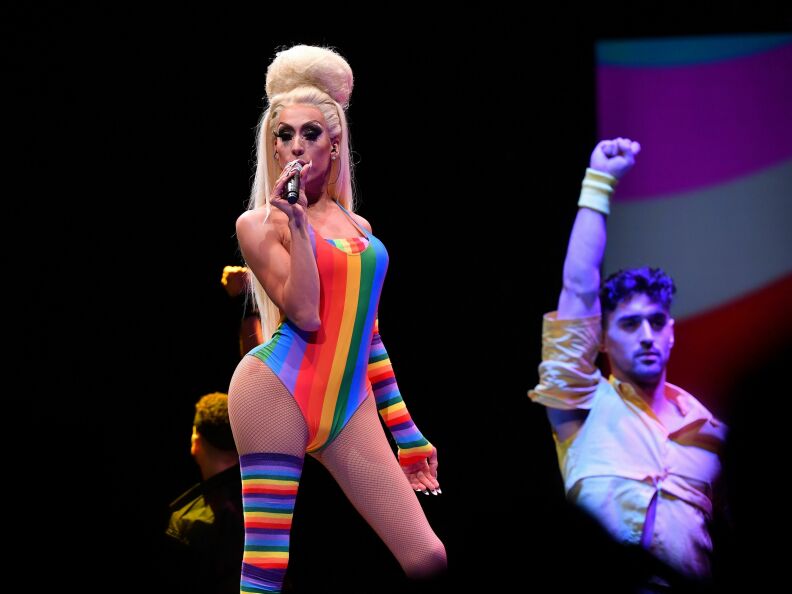Drag performers, known for their exuberance in the spotlight, have found their spirits subdued in the last month by serious concerns for their safety on stage.
Police have yet to disclose a motive behind the Nov. 19 shooting at Club Q in Colorado Springs, Colo., which left five people dead and at least 17 others injured. A 22-year-old suspect was charged with 305 criminal counts, including bias-motivated crimes.
The gunman opened fire just as Club Q was wrapping up its weekly Saturday evening drag show. The nightclub had also planned another drag show for the following morning, to honor Transgender Day of Remembrance.
Though it’s unclear if the gunman was targeting the drag show specifically or the nightclub as a whole, the attack was a tipping point for many in the drag community.
After a growing number of threats against performances and the LGBTQ-friendly venues that host them, some performers say they’ve started to use security guards, metal detectors and escape routes to ensure their shows can go on safely.
Security Guards And Designated Safe Locations

Alaska Thunderf***, shown here performing at Barclays Center in Brooklyn, N.Y., in 2019, says she’s added new security measures to her current tour in the wake of the shooting at Club Q.
(Angela Weiss
/
AFP via Getty Images)
Alaska Thunderf***, a drag queen perhaps best known as winner of the second season of RuPaul’s Drag Race All Stars, says her team has designated a safe location outside every venue on her latest tour since the shooting. Her security team has also increased the number of guards present at every performance.
Over her two decades performing drag, the possibility of violence has been “the furthest thing from my mind,” she told NPR. “Now I’m just aware there’s security guards all around this building.”
The management team for Yvie Oddly, another RuPaul’s Drag Race winner, says it’ll be sending all audience members through a bag search and metal detectors for her spring 2023 tour.
Jonathan Hamlit, the executive director of Drag Story Hour, which puts on reading events for children, says the international nonprofit is working to revamp digital and physical safety guides for the dozens of events it hosts annually.
“We’re also creating a safety marshal program called the Royal Guard, which is going to add an extra layer of volunteers — an extra set of eyes and ears and hands — to our events,” he said.
Drag as performance art, which was relegated to urban nightlife for much of the 20th century, has grown in mainstream visibility in recent years as a way to celebrate gender fluidity and self-expression, especially among the LGBTQ community and its allies. Many — though not all — drag performers identify as gay men or trans women offstage.
Drag performers are now a mainstay on reality television shows, at city brunch venues and inlibrary readings, where entertainment often intersects with lessons about diversity, acceptance and self-esteem.

A drag queen holds a “Drag Queen Story Hour” during celebrations for Pride month this past summer in Raleigh, N.C.
(Allison Joyce
/
AFP via Getty Images)
Hamlit says that family-friendly events, the latest evolution of drag, can be a key tool for expanding queer acceptance.
“The sooner kids experience otherness at a young age, they’re going to grow up to be more well-adjusted and accept people for who they are,” he told NPR. “Compassion is way more important than comprehension.”
A False Symbol Of Child Abuse
But drag’s growing popularity, especially the number of events billed as family-friendly, has also spurred its vilification.
Right-wing media and personalities have coalesced around a false narrative that drag is a left-wing plot to sexualize children.
Fox News opinion host Jesse Watters falsely saiddrag shows were designed to “change the mainstream opinion of fringe sexual activity, including, but not limited to, sex with children.”

People visit a makeshift memorial near the Club Q nightclub in Colorado Springs, Colo.
(Scott Olson
/
Getty Images)
That idea was repeated even in the days immediately following the Colorado Springs shooting. A guest on Tucker Carlson’s show said shootings would continue to happen “until we end this evil agenda that is attacking children.”
The popular “Libs of TikTok” Twitter account, which boasts 1.7 million followers, has gone so far as to start a “Mega Drag Thread” to air the locations and names of individual organizers involved in drag events.
Sophie Bjork-James, a professor at Vanderbilt University who studies gender and politics, says one can trace a clear line between relatively new conspiracy theories,like QAnon, to age-old claims of LGBTQ people being child abusers. Perhaps most famously, the group “Save our Children” spread these false claims in the 1970s in backlash to the gay rights movement.
Yet, she said, the latest child abuse framing holds a unique power: its ability to unify right-wing factions.
“There’s a lot of disagreement between the various groups — some of them are antisemitic, some are anti-immigrant,” Bjork-James said.
“But the thing everything from Fox News to extremist chat rooms on Telegram can get behind is vilifying LGBTQ people as a threat to children. It’s become the way to bring these groups together.”
Violence, Protests And Vandalism
This kind of rhetoric has been a factor behind the 141 incidents of protests or threats made against drag events in 2022, according to GLAAD, an LGBTQ advocacy organization. Some of those threats have led to violence.
In October, a Drag Queen Story Time event at an Oregon pub went on as planned as some 50 protesters, some of them armed, gathered outside. Tensions with a couple hundred counter-protesters led both sides to throw rocks and smoke grenades.
Members of the far-right nationalist Proud Boys stormed a similar story time event in California’s Bay Area this summer and confronted patrons outside events in Maryland and North Carolina.
And an Oklahoma donut shop was vandalized twice and received anti-LGBTQ messages after hosting an event featuring drag queens.
In the wake of the Colorado Springs shooting, the Department of Homeland Security warned of possible “copycat” attacks inspired by the Club Q shooting, saying that LGBTQ groups were among those who faced a “persistent and lethal threat” from violent domestic extremists.
State Legislators Propose Drag Show Restrictions And Bans

LGBTQ rights supporters protest against Florida Governor Ron Desantis outside a campaign event ahead of the midterm elections this year. Critics of the Desantis-sponsored “Don’t Say Gay” bill say it erodes protections for the LGBTQ community.
(Giorgio Viera
/
AFP via Getty Images)
In the past year, Republican lawmakers in six states have proposed or introduced bills to restrict drag performances. Though each proposal varies slightly, many revolve around a similar theme: banning minors from drag shows.
One Texas bill would classify any “performance in which a performer exhibits a gender identity that is different than the performer’s gender assigned at birth” as a “sexually oriented business,” bringing it on par with strip clubs.
In Michigan, House Republicans proposed a law that gives parents the power to sue public schools that host drag shows, despite being unable to identify any schools that had actually hosted drag shows.
Federally funded institutions such as libraries would also be banned from hosting drag shows if a federal bill proposed this October passes. Thirty House Republicans have signaled their support for the measure, according to GLAAD.
Drag performers say that each and every drag show is as unique as the performer; not every show bills itself as being appropriate for all ages.
“I think this is something we’ll have to evolve through as our audience expands,” said Thunderf***, who, if her last name didn’t give it away, rates herself as PG-13. She believes that maybe a standardized rating system could help put audiences and critics at ease.
Because, Thunderf*** says, if audience enthusiasm and ticket sales are any indication, drag isn’t leaving the spotlight anytime soon.
“If anything, I think it’s galvanized us,” she says of the shooting. “The simple act of going to a drag show now is an act of activism and an act of bravery. We’re very aware that just by doing this we may be in danger. But that’s not going to stop us.”
What questions do you have about Southern California?
-
Copyright 2022 NPR. To see more, visit npr.org.









